
* The B-47 was refined over its history, with improved bomber versions featuring more powerful engines and improved avionics, as well as a series of photographic and signals intelligence platforms. This chapter discusses the main B-47 variants; special variants and modifications are discussed in the next chapter.
* The Western Allies pursued work on turbojet engines from early in World War II; by 1943, they were considering development of operational turbojet-powered aircraft. In that year, the US Army Air Forces (USAAF) issued a requirement for a jet bomber / reconnaissance aircraft, with a formal request for proposals (RFP) following the next year, 1944. The RFP specified an aircraft with capabilities beyond those of any bomber in service in 1944, including:
The bomber was to be powered by the General Electric TG-180 turbojet engine, then in development. The Boeing, Convair, and North American companies submitted proposals. The Convair and North American were effectively contemporary piston-powered aircraft, with straight wings and the piston engines replaced by TG-180s. The first Boeing proposal, the "Model 424", was along the same lines, being something like a scaled-down B-29 Superfortress, fitted with four TG-180 turbojets, in a pod of two under each wing. The US National Advisory Committee for Aeronautics (NACA, the primary ancestor of the modern US National Aviation & Space Administration / NASA) conducted wind tunnel tests on a model of the design -- or more precisely a composite of the designs from by the three manufacturers, since their submissions were similar.
By that time, the war in Europe was clearly approaching an end. General "Hap" Arnold, head of the USAAF, asked the prominent aerodynamicist Theodore von Karman, of the California Institute of Technology, to set up a "Scientific Advisory Group (SAG)" of researchers who would travel to Europe and evaluate captured German aircraft technology. One of the members of the SAG was Boeing's chief aerodynamicist, George Schairer. While in Germany, he examined data obtained by German aircraft manufacturers on the advantages of swept wings, to find that the Germans were well ahead of the Allies in their understanding and appreciation of that technology. In May 1945, Schairer wrote a memo to Boeing management suggesting investigation of swept wings.
* Meanwhile, the USAAF had awarded study contracts to the three aircraft manufacturers working on the jet bomber project -- as well as to the Martin company, which had decided to submit a proposal as well, much along the lines of the other offerings. The four bombers would later be called "the class of 45".
By that time, however, Boeing was rethinking the Model 424 design, the NACA wind tunnel tests having showed that it suffered from excessive drag. Boeing engineers came up with a revised design in April 1944, the "Model 432" -- which retained the straight wings, but had the four engines buried in the forward fuselage. However, although the Model 432 had structural advantages, changing the engine layout didn't reduce drag very much. The Boeing engineers then turned to the swept-wing data obtained from the Germans and promoted by Schairer, with a study by Boeing aerodynamicist Vic Ganzer suggesting an optimum sweepback of 35 degrees. That led to the "Model 448" -- which had the swept wings and tail but six engines instead of four since the Boeing project manager, George Martin, had decided that the company's entry into the bomber competition needed more range and performance. It retained the four TG-180s in the fuselage, adding two more buried in the tail.
The USAAF didn't like the Model 448 and rejected it immediately. The big problem was the engines in the fuselage, which made an engine fire or disintegration likely to bring down the rest of the aircraft; the engines had to be moved back out on the wings. That led straight back to the drag problem, but the engineering team came up with a clean, elegant solution, putting the engines in streamlined pods attached under the wings. The result was the "Model 450", which featured two TG-180s in a single pod mounted on a pylon about a third of the way outboard on each wing, plus another engine slung under the wingtip.
The Air Force approved of the new design, and so the Boeing team continued to refine it. One problem was landing gear. There was no space for landing gear in the thin wings, and putting tricycle landing gear in the fuselage would have ruined the aircraft's streamlining and degraded its performance. In addition, the USAAF was now also insisting that the bomber be able to carry an atomic bomb. Since such weapons were very big at the time, that meant a long bomb bay, leaving even less room for landing gear.
The solution was a "bicycle" landing gear configuration, with two main gear assemblies arranged in a front-&-back instead of side-by-side configuration. Outrigger landing gear was to be fitted to the inboard engine pods. The arrangement had already been tested on a modified Martin B-26 Marauder bomber, the "Middle River Stump Jumper", named after the Martin plant at Middle River, Maryland.
The problem with bicycle landing gear was that it made it difficult for a pilot to "rotate" an aircraft into a nose-up position for take-off. Again, the solution was straightforward: the forward main landing gear was designed to be taller than the rear main landing gear, so that the nose-up position was the default. This little change would have a very pleasing effect on an aircraft that was already appearing to be very elegant, giving the machine the appearance of being ready to leap into the air even when it was sitting still.
There were other tweaks to the design, such as a wingtip extension to increase range. This had the effect of "moving" the outboard engines from a wingtip position to an underwing position near the end of the wings.
* The USAAF was very happy with the refined Model 450 design, and in April 1946 the service ordered two prototypes, to be designated "XB-47". Assembly began in June 1946. People working on the project were excited, since they believed, correctly, they were working on a breakthrough in aircraft design. However, most of the rest of the Boeing didn't take it seriously, it seems partly because it was so futuristic; it was easily dismissed as a "gee-whiz" experimental aircraft that would be worthless for operational use. Pictures of the initial rollout of the first XB-47 prototype show only about a hundred people in attendance. The aircraft was given the name "Stratojet" -- though few ever called it that in practice. In fact, the bomber would never be given any nickname that stuck.
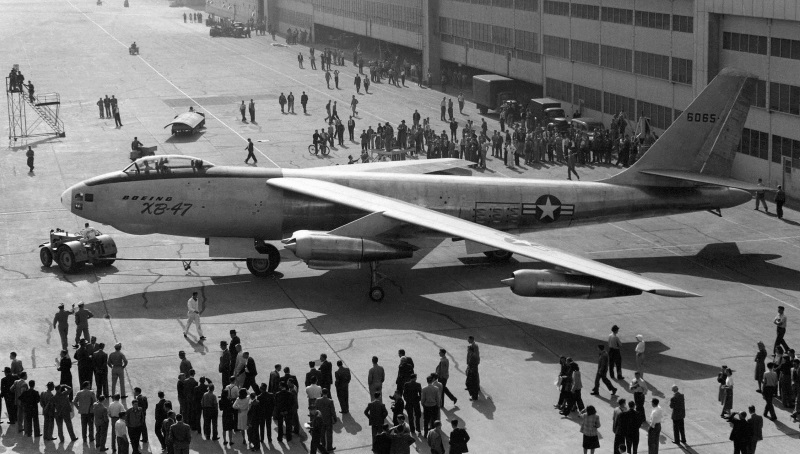
The XB-47 prototype performed its initial flight on 17 December 1947, the 44th anniversary of the first flight of the Wright Brothers, with test pilots Robert Robbins and Scott Osler at the controls. The aircraft flew from Boeing Field in Seattle to the Moses Lake Airfield in central Washington state, the flight lasting 52 minutes. There were no serious problems, except that Robbins had to pull up the flaps using the emergency hydraulic system; the engine fire warning lights kept popping on as well. Robbins reported that the aircraft flew well.
BACK_TO_TOP* The XB-47 was seen as a futuristic "Buck Rogers" aircraft. The 35-degree swept wings were shoulder-mounted, with the twin inboard turbojet engines mounted on a pylon in a tidy pod, and the outboard engine tacked under the wing just short of the wingtip.
The airfoil sectional chord had a height-length ratio of 11. That was unusually thin, as required for high-speed flight -- but the wing could flex as much as 1.5 meters (5 feet) up or down, which made the design engineers uneasy. Considerable work was accordingly performed to make sure the aircraft could fly right, even as the wings flexed. In practice, it wouldn't prove to be much of an issue. The wings were fitted with "Fowler flaps", extending well behind the wing, to reduce take-off length. The retractable bicycle landing gear, dictated by the thin wing, consisted of a set of dual wheels fore and aft of the bomb bay, with small outrigger wheels extending on the inboard twin-jet pods.
The Model 450 was expected to be as fast as fighters then on the drawing board, and so the only defensive armament was to be a tail turret with two 12.7-millimeter (0.50-caliber) Browning machine guns, to be directed by a radar-directed automatic fire-control system. The two XB-47s, being test machines, didn't have the tail turret or any other combat systems. Fuel capacity was an extraordinary 64,400 liters (17,000 US gallons), contrasted with 19,000 liters (5,000 US gallons) on the B-29. Maintaining fuel trim to ensure a stable center of gravity in flight was a major issue in design of and flight training for the aircraft.
The initial prototypes were powered by GE "J35" turbojets, the production version of the TG-180, with 17.66 kN (1,800 kgp / 3,970 lbf) thrust each. Early jet engines did not develop good thrust at low speeds, so to assist in take-offs in heavily loaded condition, the XB-47 prototype was to have 18 solid-fuel "jet-assisted take off (JATO)" rockets with 4.41 kN (450 kgp / 1,000 lbf) thrust each. Nine such units were built into each side of the lower rear fuselage, arranged in three rows of three bottles.
The XB-47, being big and sleek, also has an uncomfortably high landing speed. Late in flight testing, following a suggestion by Air Force test pilot Major Guy Townsend, a 9.75-meter (32-foot) drag chute was fitted to the XB-47 to slow it down on landing. A conventional parachute would be ripped apart, so a ribbon parachute, derived from German designs, was used instead. A related problem was that the J35 engines had to be throttled down to reduce speed on landing approach. Since it could take as long as 20 seconds to get them back up to full power, the big aircraft could not do a "touch and go" on a bad landing, to circle around and try again. The solution to that problem was to add a second, half-diameter drag chute that could be deployed on approach, allowing the engines to remain throttled up.
The XB-47 was flown by three crew in a pressurized forward compartment: a pilot and copilot in a long fighter-style bubble canopy, along with a navigator in a compartment in the nose. The copilot also served as tail gunner, and the navigator as bombardier. The bubble canopy could pitch up and slide backward -- but since the cockpit was high off the ground, crew entry was through a door and ladder on the underside of the nose. Total bombload was to be 4.5 tonnes (10,000 pounds). Production aircraft were to be equipped with, by the standards of the time, with advanced electronics for navigation, bombing, countermeasures, and turret fire control.
* The second XB-47 prototype performed its first flight on 21 July 1948; it was fitted with substantially more powerful GE J47-GE-3 turbojets, the J47 being an improved derivative of the J35 / TG-180. The J47-GE-3 engines could provide 23.54 kN (2,400 kgp / 5,200 lbf) thrust each. The J47 or "TG-190" was an improved derivative of the J35 / TG-180. The first XB-47 prototype was eventually retrofitted with the same engines.
Since the design was so radical, flight testing of the prototypes was particularly cautious and methodical. The prototypes initially suffered from "Dutch roll", an instability that caused the aircraft to weave in widening "S" turns. That problem was fixed by the introduction of a "yaw damper" control system that applied rudder automatically to damp out the weaving. The prototypes also had an inclination to pitch up; that problem was solved by tacking small vanes, or "vortex generators", onto the wings. The vortex generators produced turbulence to prevent separation of airflow from the wings.
Boeing test pilot Rob Robbins had originally been worried about the XB-47, saying that before the initial flight he had "prayed to God to please help me" through the flight. The aircraft was so unusual that he wasn't sure it would fly. Robbins soon realized that he had an extraordinary aircraft. In early 1948, the Air Force (the "USAF", having become a separate service in 1947) sent up a chase plane from Muroc Air Force Base -- now Edwards AFB -- in California to help calibrate the bomber's airspeed system. Robbins reported later:
QUOTE:
[The chase plane] was a P-80 [Lockheed Shooting Star] and Chuck Yeager was flying it. Chuck's a hell of a good pilot, but he had a little bit of contempt for bombers and a little disdain for civilian test pilots. Well, we took off, climbed out, and got up somewhere within four or five points of full throttle speed.
At that point, Chuck called me on the radio and said: "Bob, would you do a 180?" I thought: Hey, Chuck's smart, he just wants to stay reasonably close to Moses Lake, he doesn't have as much fuel as I do. Well, I turned around, got stabilized, and looked for Chuck. He wasn't there. Finally, I got on the radio and said: "Chuck, where are you?"
He called back and rather sheepishly said: "I can't keep up with you, Bob." So Chuck Yeager had to admit to a civilian test pilot flying a bomber that he couldn't keep up! That was something!
END_QUOTE
* By mid-1948, the Air Force's bomber competition had already been through one iteration, pitting the North American XB-45 against the Convair XB-46. The North American design won that round of the competition; as an interim measure, the USAF had decided to put the North American bomber into production on a limited basis as the "B-45 Tornado". The expectation was that B-45 production would be halted if either of the remaining two designs in the competition, the Boeing XB-47 and the Martin XB-48, proved superior.
The XB-47 was clearly far ahead of the XB-48, but it was too exotic for many USAF generals to take seriously. In July 1948 USAF General K.B. Wolfe, in charge of bomber production, visited Boeing in Seattle; Boeing president Bill Allen suggested that the general take a ride on the XB-47. Wolfe was reluctant, but Allen and others talked him into it, with Guy Townsend gave Wolfe a great ride. In early August, Wolfe contacted Boeing and said the Air Force wanted to place an order for ten more of the new Boeing jet bombers. A formal contract was signed on 3 September 1948.
These ten machines were "B-47As", the first being delivered in December 1950. They were strictly evaluation aircraft, very close in configuration to the XB-47 prototypes. They were powered by J47-GE-11 turbojets, providing the same 23.54 kN (2,400 kgp / 5,200 lbf) thrust as the earlier J47-GE-3, and they also featured the built-in JATO bottles.
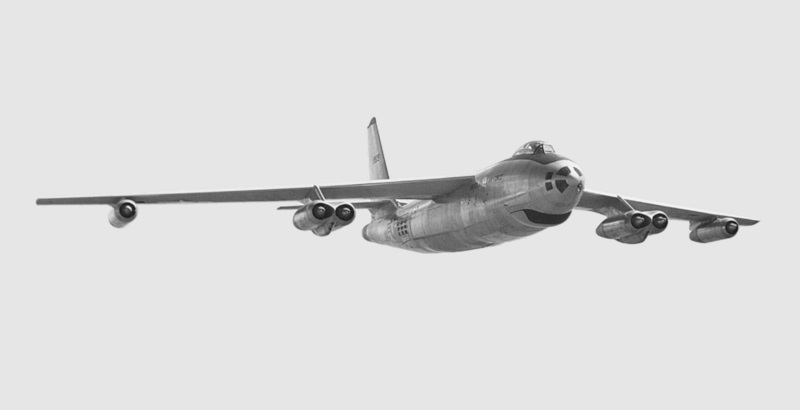
Four of the B-47As were equipped with the K-2 bombing and navigation system (BNS) -- featuring an HD-21D autopilot, an analog computer, AN/APS-23 radar, and a Y-4 or Y-4A bombsight. Two B-47As were fitted with the tail turret, one of them using an Emerson A-2 fire control system (FCS), another early version of the GE A-5 FCS. The eight other B-47As had no defensive armament. The B-47As were fitted with ejection seats; the pilot and copilot ejected up, while the navigator ejected down, with minimum safe ejection altitude being about 150 meters (500 feet).
Although the XB-47s had been built by Boeing at the company's plant in Seattle, Washington, the B-47As and all later Boeing B-47 production were produced at a government-owned factory in Wichita, Kansas, where the company had earlier built B-29s. The shift was made since the Seattle plant was burdened with KC-97 Stratotanker production and other urgent tasks, while the Air Force also thought Seattle was too vulnerable to a Soviet bomber attack.
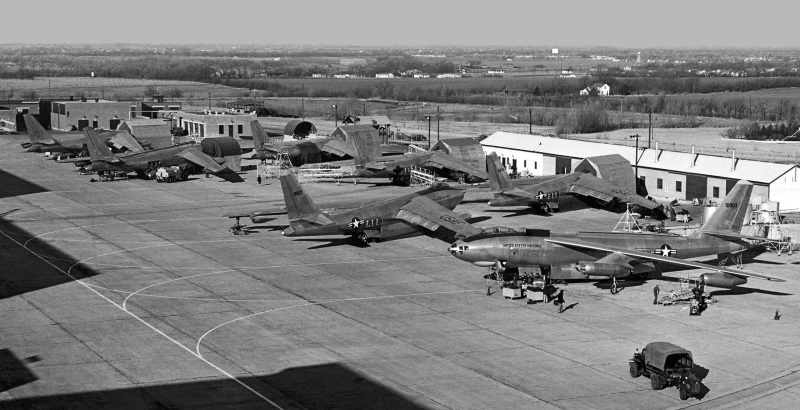
Most of the B-47As had been phased out of service by early 1952, though one did perform flight tests for NACA for a few more years. By 1952, the Cold War was increasing in intensity, with a hot war flaming away in Korea. The USAF's Strategic Air Command (SAC) needed an effective nuclear deterrent to keep the Soviet Union in line; the B-47 was seen as the best tool for the job, with Boeing already working on production bombers.
BACK_TO_TOP* Following the award of preliminary contracts for production B-47s, in November 1949, before the B-47A had flown, the Air Force had ordered 87 "B-47Bs", the first operational variant. The first B-47B took to the air on 26 April 1951. A total of 399 was built, including eight assembled by Lockheed and ten assembled by Douglas, using Boeing-supplied kits. The USAF was in a hurry to get their hands on as many B-47s as they could as fast as possible, and so Lockheed and Douglas were signed up for additional production. Lockheed-built B-47s were designated with a "-LM (Lockheed Marietta)" suffix, while Douglas-built B-47s were given a "-DT (Douglas Tulsa)" suffix. Boeing production was assigned a "-BW (Boeing Wichita)" suffix, except for the Seattle-built XB-47s and B-47As, which had a "-BO" suffix.
The initial batch of 87 B-47Bs was powered by the same J47-GE-11 engines as the B-47As, but all later production had substantially uprated J47-GE-23 turbojets with 25.8 kN (2,630 kgp / 5,800 lbf) thrust each; early production B-47Bs were upgraded with the improved engines. All B-47Bs featured the built-in JATO rocket scheme used on the XB-47 and B-47A.

They were also fitted with complete combat systems. Early production used the K-2 BNS installed on some of the B-47As, but later production featured the K-4A BNS, which included an AN/APS-54 tail warning radar and an AN/APT-5 electronic countermeasures (ECM) system. The K-4A used a periscopic bombsight fitted into the tip of the nose of the aircraft, with the transparent plexiglas nose cone of the XB-47 and B-47A replaced by a metal nose cone, with four small windows on the left side of the nose and two windows on the right. Another visible change from the earlier models was that the B-47B's tailfin had a squared-off top, instead of the rounded top of its predecessors.
The bomb bay of the B-47B was shorter than that of the XB-47 and B-47A, since nuclear weapons had become smaller in the meantime. However, thanks to the uprated engines, the B-47B could carry a much larger bombload, up to 8,165 kilograms (18,000 pounds). All B-47Bs featured the tail turret with twin 12.7-millimeter guns and the B-4 radar-guided FCS -- though the B-4 proved troublesome, so troublesome that in some B-47Bs it was replaced with an N-6 optical sight. The copilot could swivel his seat around to face backward and direct the guns.
In practice, the enormous fuel capacity of the B-47 still could not give it the range the Air Force wanted. Solution of this problem was a high priority, and so an in-flight refueling (IFR) socket was fitted in the right side of the nose for "boom"-style refueling, which was the main reason for getting rid of the plexiglas nose cone.
The B-47B was also fitted with a jettisonable external tank under each wing, carried between the inboard and outboard engine assemblies. These were really big drop tanks, with a capacity of 6,750 liters (1,780 US gallons).

The B-47B was substantially heavier than B-47A, and so as a weight-reduction measure the ejection seats were deleted, with a windbreak panel was fitted to the aircraft's main door to make escapes easier. Some sources also claim that a fatal ejection-seat accident in a B-47A contributed to this decision. Whatever the case, aircrews were not happy with the deletion of the ejection seats, since getting out of the aircraft even at altitude was troublesome. Bob Robbins recalled that George Martin, the B-47 program manager, showed him the letter from the Air Force ordering Boeing to remove the seats, and told him: "Bob, put that letter in a safe place. The day is going to come when the Air Force is going to regret this decision, and we want to be able to make it very clear where the decision came from to do away with the ejection seats."
BACK_TO_TOP* The designations "B-47C" and "B-47D" were applied to special variants that never went into production, described later, and so the next production version of the B-47 was the definitive "B-47E".
The first B-47E flew on 30 January 1953. Four "blocks" or "phases" of the B-47E were built, each adding refinements over the previous block; there were also sometimes production changes within a block. Older blocks were usually brought up to the specifications of later blocks as they were introduced.
Early production "B-47E-Is" featured J47-GE-25 turbojets with 26.59 kN (2,710 kgp / 5,970 lbf) thrust each. They were soon updated to J47-GE-25A engines, featuring water-methanol injection -- a scheme in which a water-methanol mix was dumped into the engines at take-off, increasing mass flow and so kicking the thrust up to 32.03 kN (3,265 kgp / 7,200 lbf). It seems the methanol was added as anti-freeze. Water injection caused the engines to pour out black smoke due to incomplete combustion, and also generate a thunderous roar.
Water-methanol injection reduced the need for JATO, which was expensive and had its hazards. From that time on, it was reserved for emergency alerts, when bombers had to get into the air as fast as possible. It was otherwise only done once a year or so, for training.

Early B-47E-Is still had provisions for the 18 built-in JATO bottles -- but there were worries about having the JATO bottles so close to full fuel tanks, and once the rocket bottles were exhausted they were just dead weight anyway. Since JATO launches were rarely performed, the built-in JATO system was deleted, to be replaced by an external, jettisonable "split vee" or "horse collar" rack fitted under the rear fuselage. The rack carried 33 JATO bottles, in three rows of 11 bottles. The racks were expendable, being dropped onto closed range areas after take-off.
The internal fuel capacity of initial production B-47Es was cut to 55,371 liters (14,610 gallons) as a weight-saving measure. That was considered acceptable because of the big external tanks, plus the fact that the USAF had refined mid-air refueling to a mature and reliable practice.
One particularly welcome change in the B-47E relative to the B-47B was the restoration of the ejection seats, Air Force brass having realized their deletion didn't make sense. In addition, the twin 12.7-millimeter guns in the tail turret were replaced with twin 20-millimeter cannon with more punch, directed by an A-5 FCS in early production and an MD-4 FCS in later production.
One more change in the B-47E was that most of the windows in the nose were deleted, with only one left on each side -- though many pictures of B-47Es show them with the full set of windows used on the B-47B. These may have been B-47Bs updated to B-47E specification, though it's possible early B-47E production retained the B-47B window arrangement.
* The "B-47E-II" featured minor tweaks from late production B-47E-Is, while the "B-47E-III" featured an ECM suite, consisting of a radar jammer in a bulge under the fuselage plus a chaff dispenser, as well as improved electrical alternators.
The "B-47E-IV" was a much more substantial update, featuring reinforced landing gear, a stronger airframe, more fuel capacity, and bombload increased to 11,340 kilograms (25,000 pounds). The bomb bay was once again shortened because of the introduction of more compact nuclear weapons.
Another improvement was the introduction of the MA-7A BNS, a big step up from its predecessors. The MA-7A included the AN/APS-64 radar, with a range of up to 385 kilometers (240 miles); it could be used as a long range "identification friend or foe (IFF) transponder" interrogator to help a B-47E-IV to find a tanker or other B-47, or it could be used as a high-resolution ground-targeting radar. The B-47E-IV retained the optical bombsight, though it was rarely used.
___________________________________________________________________
BOEING B-47E-IV:
___________________________________________________________________
wingspan:
35.4 meters (116 feet)
wing area:
132.66 sq_meters (1,428 sq_feet)
length:
32.6 meters (107 feet)
height:
8.5 meters (27 feet 11 inches)
empty weight:
35,860 kilograms (79,075 pounds)
max loaded weight:
104,300 kilograms (230,000 pounds)
maximum speed:
1,030 KPH (640 MPH / 555 KT)
service ceiling:
12,300 meters (40,500 feet)
take-off run:
3,170 meters (10,400 feet)
range with tanks:
6,495 KM (4,035 MI / 3,510 NM)
___________________________________________________________________
A total of 1,341 B-47Es was produced, with 691 built by Boeing, 386 by Lockheed, and 264 by Douglas. Most B-47Bs were rebuilt up to B-47E standards under two consecutive programs, designated HIGH NOON and then EBB TIDE. They were given the designation of "B-47B-II" -- though it appears that in practice they were simply called B-47Es.
BACK_TO_TOP* The B-47E led to a series of major long-range reconnaissance variants.
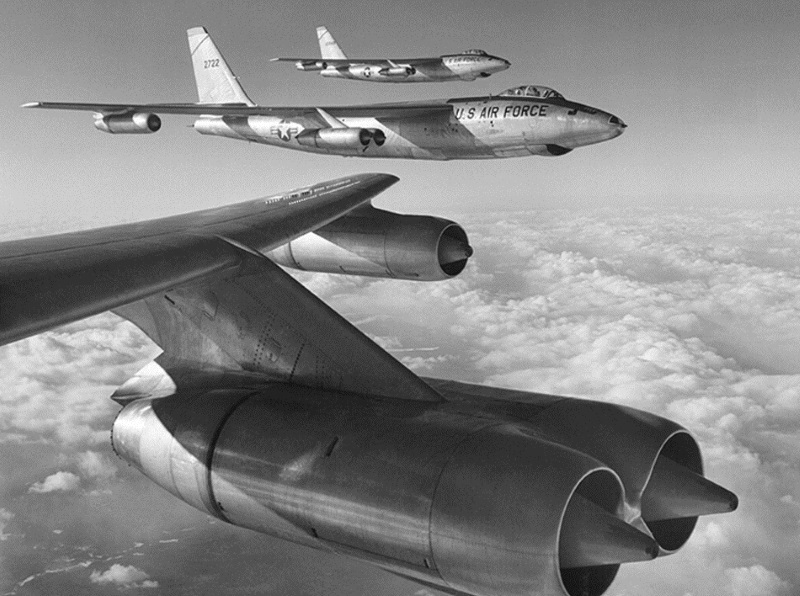
Boeing-Wichita built 240 "RB-47E" reconnaissance machines -- similar to the B-47E but with a nose stretched by 86 centimeters (34 inches), giving them an arguably more pleasing appearance than the bomber variants of the B-47. The long nose was used to stow up to 11 cameras, which could include:
The RB-47E could carry photoflash flares for night reconnaissance. Its fuel capacity was increased to a total of 70,000 liters (18,400 US gallons). The navigator controlled the cameras, becoming a "navigator-photographer" instead of a "navigator-bombardier".
* There were "F" and "G" variants of the B-47, but they were all one-off conversions of B-47Bs or B-47Es, discussed later. That means the next production version in the family was the "RB-47H", with 32 built for the built for the electronic intelligence (ELINT) mission, along with as three more-specialized "ERB-47Hs". These machines featured a distinctive blunt, rounded nose, and also sported blisters and pods for intelligence-gathering antennas and gear. They were designed to probe adversary defenses to collect data on radar and defense communications signals.
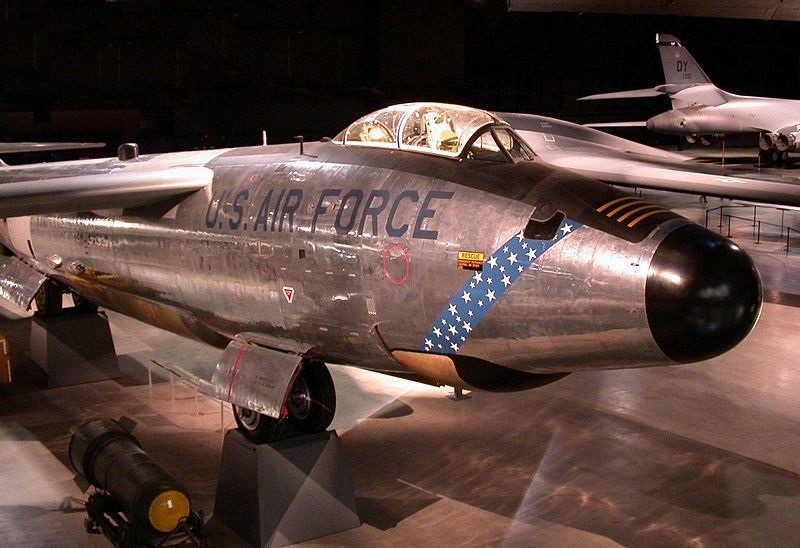
The bomb bay was replaced by a pressurized compartment, which accommodated "electronic warfare officers (EWO)", informally known as "crows" or "ravens". There were three EWOs on board the RB-47H, but only two on the ERB-47H. A distinctive bulged fairing replaced the bomb bay doors. The RB-47H / ERB-47H retained the tail turret, and were also fitted with jammers and chaff dispensers. The only visible difference between the RB-47H and ERB-47H was that the ERB-47H had a small but distinctive antenna fairing under the rounded nose.
The first RB-47H was delivered in August 1955. The ELINT B-47s proved valuable, and were put through a "Mod 44" or "Silverking" update program in 1961 to fit them with updated electronics systems. Silverking aircraft could be easily recognized by a large teardrop pod for ELINT antennas attached to a pylon -- mounted under the belly and offset to the right side of the aircraft -- as well as a pylon-style antenna attached under each wing beyond the outboard engine. It is unclear if all RB-47Hs and ERB-47Hs were updated to the Silverking specification.
* The RB-47H and ERB-47H were very capable aircraft, but the EWO compartment was cramped, with sitting room only, and suffered from both poor noise insulation and climate control. Long missions were, as a result, very uncomfortable and tiring; some sources say that the EWOs even had to deal with fuel leaks on occasion. Getting out in an emergency was also troublesome. The EWOs had ejection seats that would cut a hole through the compartment floor when fired, but nobody had much trust in the scheme, with rumors that test firings with dummies had often resulted in decapitations.
Operations of the RB-47H and ERB-47H were top secret, with the missions usually flown at night and even base commanders often not knowing what was going on. When crews were asked what they were doing, they always replied that such information was classified. On inquiries on what the blunt black nose was for, they would sometimes explain that it was a bumper, used in in-flight refueling in case they nosed into the tanker. While a few of these aircraft performed special duties during the Vietnam War, such as relaying ELINT data from drones, they were eventually replaced by much more comfortable and capable Boeing RC-135 platforms. The last RB-47H was retired on 29 December 1967.
* There was never an "I" variant in the B-47 series; the Air Force didn't use "I", since it was too easy to confuse with a "1". There was a "J" variant, but it was another one-off modification, also discussed later. That means the very last B-47 production variant was the "RB-47K", which were RB-47Es with gear for the weather reconnaissance mission. Initial deliveries were in December 1955. The RB-47Ks typically carried a load of eight "dropsonde" weather sensors that were released at various checkpoints along the aircraft's flight path. Data radioed back from the dropsondes was logged using equipment operated by the navigator. The RB-47Ks stayed in service until 1963.
BACK_TO_TOP